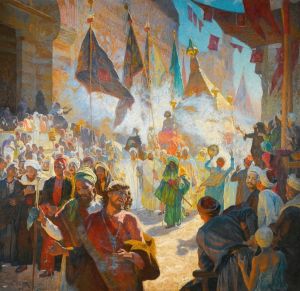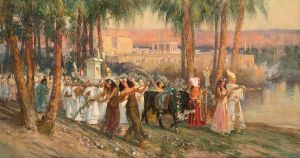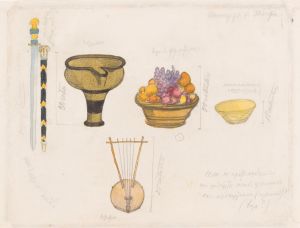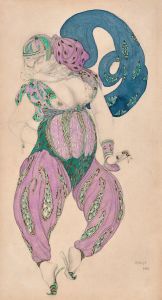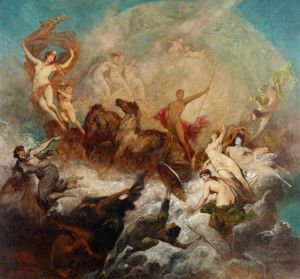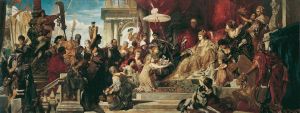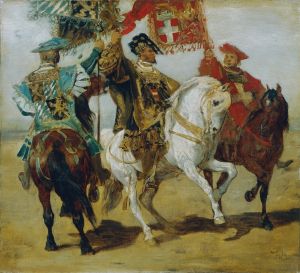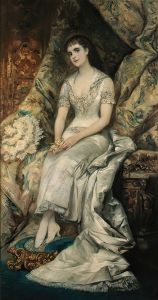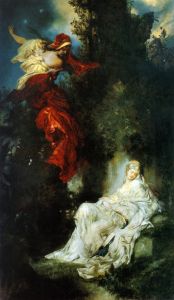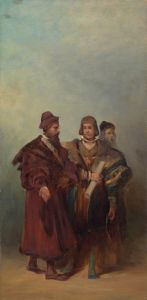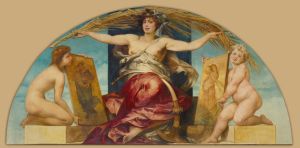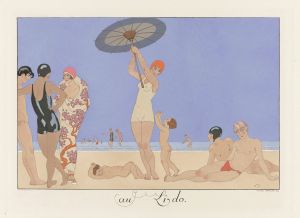
Entwurf zum Festzug 1879 – Die Bekleidungsindustrie
A hand-painted replica of Hans Makart’s masterpiece Entwurf zum Festzug 1879 – Die Bekleidungsindustrie, meticulously crafted by professional artists to capture the true essence of the original. Each piece is created with museum-quality canvas and rare mineral pigments, carefully painted by experienced artists with delicate brushstrokes and rich, layered colors to perfectly recreate the texture of the original artwork. Unlike machine-printed reproductions, this hand-painted version brings the painting to life, infused with the artist’s emotions and skill in every stroke. Whether for personal collection or home decoration, it instantly elevates the artistic atmosphere of any space.
Hans Makart was an Austrian painter known for his influence on the Viennese art scene in the late 19th century. One of his notable works is "Entwurf zum Festzug 1879 – Die Bekleidungsindustrie," which translates to "Design for the Parade 1879 – The Clothing Industry." This painting is part of a series of designs created by Makart for the grand parade celebrating the silver wedding anniversary of Emperor Franz Joseph I and Empress Elisabeth of Austria in 1879.
Makart was commissioned to design the parade, which was a significant cultural event in Vienna. The parade was intended to showcase the achievements and industries of the Austro-Hungarian Empire, and Makart's designs played a crucial role in its visual impact. His work for the parade included a series of allegorical floats, each representing different aspects of the empire's economy and culture.
"Die Bekleidungsindustrie" specifically highlights the clothing industry, an important sector in the Austro-Hungarian economy at the time. Makart's design would have been intended to celebrate the craftsmanship, creativity, and economic significance of the textile and fashion industries. While the original painting or design for this specific float may not be widely reproduced or available, it is understood to be part of Makart's broader vision for the parade, which was characterized by its opulence and grandeur.
Makart's style is often described as lavish and theatrical, with a strong emphasis on color and movement. His work was influenced by the Baroque period, and he was known for his ability to create dramatic compositions that captivated the public. This approach would have been evident in his designs for the parade, including "Die Bekleidungsindustrie," where he likely employed rich colors and dynamic figures to convey the vibrancy and importance of the clothing industry.
The 1879 parade was a significant event in Vienna, reflecting the city's cultural and economic status in Europe at the time. Makart's involvement in the parade solidified his reputation as a leading artist in Vienna, and his designs were celebrated for their artistic merit and contribution to the festivities. The parade itself was a reflection of the Austro-Hungarian Empire's diversity and achievements, with Makart's designs serving as a visual representation of these themes.
While specific details about "Die Bekleidungsindustrie" may be limited, it is clear that Makart's work for the 1879 parade was an important part of his artistic legacy. His ability to blend art with public spectacle made him a key figure in the cultural life of Vienna, and his designs for the parade remain a testament to his skill and vision as an artist.





